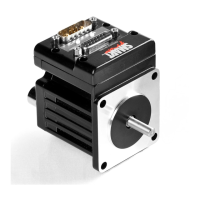Moog Animatics SmartMotor™ Developer's Guide,Rev. L
Page 545 of 909
-1.0
0
1.0
Sine
Trapezoid
Sine vs 6-Step Trapezoid Commutation
Leading areas of higher current
resulting in greater torque for
trapezoidal commutation
Magnetic Cycle
Because MDS uses the encoder, for motors with incremental encoders, it requires angle
match (the first sighting of the encoder index) before it will engage. MDS is the best choice for
applications that require extremely smooth and quiet rotation at low speeds.
Use status word 6 to see the active commutation mode.
NOTE: MDE, MDS and MDC require angle match before they will take effect. This
means the SmartMotor's factory calibration is valid and the index mark of the
internal encoder has been seen after startup. The default commutation mode for
D-style motors is MDT (see MDT on page 546); the default commutation mode for
M-style motors is MDC (see MDC on page 536).
EXAMPLE:
MDS 'Set sine mode
'Will remain in sine mode until commanded otherwise
MV 'Set velocity move
VT=50000 'Set velocity target
ADT=10 'Set accel/decel target
G 'Start motion
END
RELATED COMMANDS:
MDB Enable TOB Feature (Commutation Mode) (see page 534)
MDC Mode Current (Commutation Mode) (see page 536)
MDE Mode Enhanced (Commutation Mode) (see page 538)
MDH Mode Hybrid (Commutation Mode) (see page 540)
MDHV Mode Hybrid Velocity (Commutation Mode) (see page 542)
MDT Mode Trap (Commutation Mode) (see page 546)
Part 2: Commands: MDS

